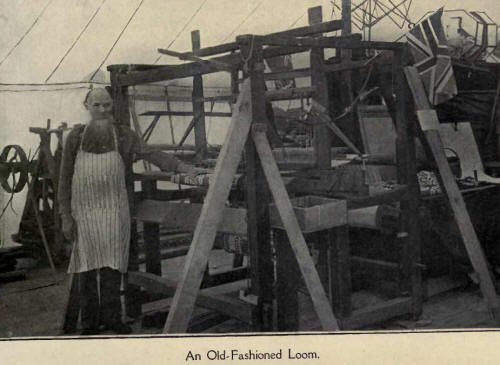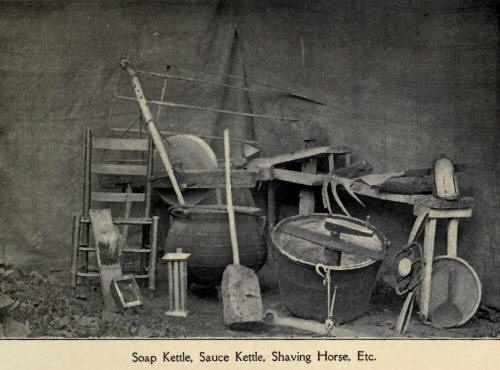|
EARLY FARM IMPLEMENTS—TEN SICKLE OR REAPING HOOK
SOWING THE GRAIN - CRADLING GRAIN - THE
REAPING MACHINE—SHEEP WASHING AND SMEARING.
ALL the farm implements in the early days
were made by hand, the wooden part being
made by the farmer himself, and the iron part by
the wayside blacksmith, although some of the farmers had forges of their
own and were ingenious enough to do their own blacksmithing. The
implements used by the pioneers were few and simple compared with those
used by the farmers of the present day. The chief farming implements were
the plough, harrow, cradle, sickle, rake, scythe and roller.
Many improvements have been made in the plough of recent years. The first
plough was made of wood (usually a piece of bent oak), and covered with
iron. Some very rude ones were made out of a natural crook, as the root of
a tree; others had wooden mould boards and iron points.

The first harrow used in the backwoods clearings was
the "three-cornered drag," a V-shaped framework of wood, with cross-pieces
and fitted with iron teeth. It was often made out of the crotch of a tree,
holes being bored for the iron teeth. This kind of harrow was particularly
well adapted for working up the soil in the stumpy ground, as, on account
of its shape, it did not catch on to the stumps so easily as the square
harrow.
The "brush" or "bush" harrow, made of a bunch of
brushwood, was sometimes made to answer the purpose of a harrow in the
loose soil of the new ground, which very often did not require any
ploughing at all the first time cropped. In the cleared ground, the square
harrows, made of wood with iron teeth, were used. These were afterwards
made in two parts and hinged together. This kind of harrow has been almost
entirely superseded by the harrow made of steel.
The only kind of rake was the wooden hand-rake; later
on, the wooden lift-rake, and the wooden dump- rake, drawn by a horse,
came into existence. The farmer walked behind and held the handles until
sufficient hay had been collected, when he would lift or dump it in rows.
These rake3 were followed by the sulky-rake now in use.
For levelling off the lumpy ground the farmer had a
roller, made out of a heavy log of wood, with a tongue attached to it, to
hitch the horses to. The minor farm implements were the long-handled
shovel and spade and the pitchfork, the hoe and garden rake, all very
heavy and clumsily made of iron, while nowadays such implements are made
of steel, and consequently much lighter and better finished. There were
wooden forks for pitching straw. The manure forks were generally made with
broad tines and very heavy.
The old farm wagon had wooden axles with a strip of
iron above and below, to prevent the wood from wearing away. They were
greased with tar, made from the pitch got from' the pine trees, and mixed
with lard in the winter time, to prevent it from becoming too thick. The
tar was kept for the purpose in a special bucket, which was hung
underneath the back of the wagon when on a long journey.
The wheels of the old "lumber" wagon were kept in place
by linch-pins, which were dropped through a hole in the end of the axle,
but as they did not secure the wheel very tightly when the wagon was in
motion, they made a rattling noise, which could be heard for quite a
distance away. There being no iron wagon springs, the seat was perched on
the end of two poles with the ends fastened in the wagon box. This
"spring-pole" wagon-seat, although high up in the air, was the most
comfortable one known.

The Sickle and Reaping Hook.
In the early days of the country all the grain was cut by means of the
sickle, a curved knife a couple of feet long, with indented teeth. This
was the only kind of harvest instrument the farmer had for years for
cutting grain, the cradle being then unknown. To cut a field of grain with
it must have been a slow and tedious as well as a very tiring process.
With all hands on the farm to help, however, both male and female, the
harvesting was soon accomplished. It is interesting to hear some of the
old folks tell how first the grain was sown, cut, threshed and got ready
for the mill. It was frequently planted in the stumpy ground with a hoe or
rake. When ripe it was cut with the sickle, bound in sheaves, and taken on
the jumper to the threshing-floor, which was often no better than a big
flat stone, sometimes a floor of boards, and sometimes even the bare
ground, tramped hard and smooth, where, by means of the flail, or
"poverty-stick" (two pieces of hardwood united by leather), the heads were
pounded until the grain was all threshed out. It was then "winnowed," or
cleaned, by pouring from one vessel to another in the
wind, until it was free of the chaff, after which several bags were put
across a horse's back and sent to the mill—often fourteen or fifteen miles
or more distant—to be ground into flour, the farmer having to wait
patiently his turn for this to be done, and which sometimes kept him from
home for several days together. It was not an uncommon thing for some of
the old settlers who had no horses to have to carry the bags of wheat to
the mill on their backs for long distances of fifteen or twenty miles. The
first mills were situated on some stream or creek, where water-power could
be obtained, as there were, of course, no steam mills then in the country.
These water-power mills were scarce, even, people sometimes going forty
and fifty miles to get their grists ground hand mills for grinding wheat
were furnished by the Government to the U. E. Loyalists, and those who did
not have these hand-mills would burn a hole in the top of a white oak
stump; into this hollow, when well scraped out, they would place the wheat
or corn and grind it into a coarse meal with a pestle made out of a piece
of hard wood. This was probably in imitation of the Indian method of
grinding their corn in stone cups or bowls. To facilitate the operation
the pestle was sometimes fastened to the end of a spring pole extended
over a forked stick stuck in the ground. The first crop of the settlers
usually consisted of a field of wheat and peas, with a small patch of
potatoes, pumpkins and corn.
Sowing the Grain.
Formerly the farmer in sowing his grain had a sack tied
around his body and as he walked over the ground he scattered the seed
with a sweep of his hand. With measured step he strode forward and did his
work carefully and manfully. This method of sowing grain was common for
centuries. Our Saviour speaks of it in His parable of the sower. Since the
seed drills were introduced, forty or fifty years ago, the old-fashioned
way of sowing has gradually been discarded, until now there is scarcely a
farm that is not equipped with a seed drill.
Cradling Grain.
Following the sickle came the cradle, which consisted
of a framework or "rigging" of wood for gathering the grain together as it
was being cut, fixed to the scythe, an instrument which previous to this
time had only been used for cutting grass. The farmer, with a sweeping
stroke of his brawny arms, would cut down a "swath" of from four to six
feet in width. The binders (men and women) would follow with their rakes
and, after raking enough together for a sheaf, would twist a handful of
the stalks into a strand and bind up the bundle. An expert cradler could
cut as much as three or four acres of good standing grain in a day, about
as much as three or four men could bind. After the grain had been bound it
was gathered together and stood on end, two sheaves in a pair, in "stooks"
or "shocks" of ten or twelve sheaves, to dry.
The Reaping Machine.
The cradle was superseded by the reaping machine, which
has been the subject of many improvements up to the present time, since
its introduction in 1831, when a man walked behind and raked the grain off
the table as it was being cut. In 1845 a seat was made for this man at the
rear of the machine, and in 1863 a self- raking attachment was added,
until now we have machines which not only cut the grain but also bind it
into sheaves as well. The advent of the reaping machine is a striking
illustration of the truth of the old saying, "Necessity is the mother of
invention." The inventor, who lived in the Western States, saw the need of
a machine that would cut the grain in the big fields of the western
country just opening up to settlement more rapidly than it could be done
by the old methods. This idea of saving labor has been carried out with
all kinds of work, until now there is scarcely any department of labor in
which machinery does not do the bulk of the work.
Sheep Washing and Shearing.
In the spring of the year, generally the last of May or
the first of June, the sheep were driven into an enclosure beside some
stream, and one by one taken by the farmer and his men and washed in the
stream, so as to get their wool clean and white. After a day or two of
drying the sheep were shorn of their fleeces. The wool was then picked
over by the women and girls, to get out any burs or lumps of dirt that
might have adhered to it, "picking" bees being frequently made for this
purpose. After the picking, in order to make the wool soft and pliable, it
was spread out on the floor and greased by sprinkling melted lard over it
and next whipped with a rod, after which it was bundled up in big woollen
blankets, pinned together with a thorn from a hawthorn bush and sent away
to the carding mill to be carded into rolls for spinning. Many of the
farmers, when carding mills, were not convenient, did their own carding
with the old-fashioned hand cards. If the farmer had a large number of
sheep he would often make a bee for the washing and the shearing. If the
sheep were afflicted with "tick" or vermin a solution of tobacco leaves
was made and applied to the skin of the sheep.
A flock of sheep after being sheared were and are quite a lean and
awkward-looking sight; pitiable, shivering, starving-looking creatures,
seeming different animals altogether from the well-wooled sheep that gave
good promise of fat mutton.
NOTE—Nowadays many farmers do not pay much
attention to sheep raising; they buy their clothing from the merchant and
the butcher makes his rounds through the country and supplies them with
fresh meat, but in our grandfather's time they were obliged to keep a
good-sized flock of sheep. The wool of the sheep they made into clothing,
and when fresh neat was required for family use and for the threshings,
etc., the flock was robbed of one of its most promising-looking members.
Years ago there was no market in the towns and villages for mutton and
other meats. What the farmer raised he raised for his own use principally,
as there was no foreign market as there is now.

|

